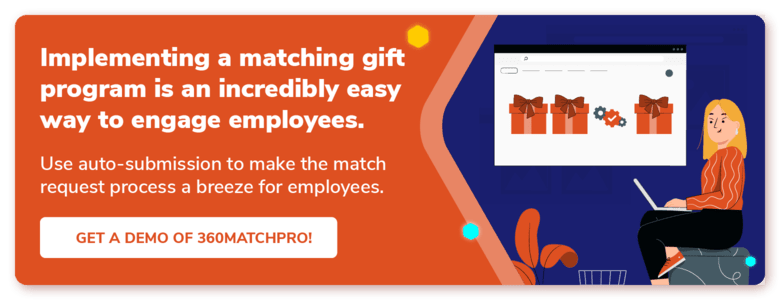Mastering Employee Engagement: Best Practices + 13 Ideas
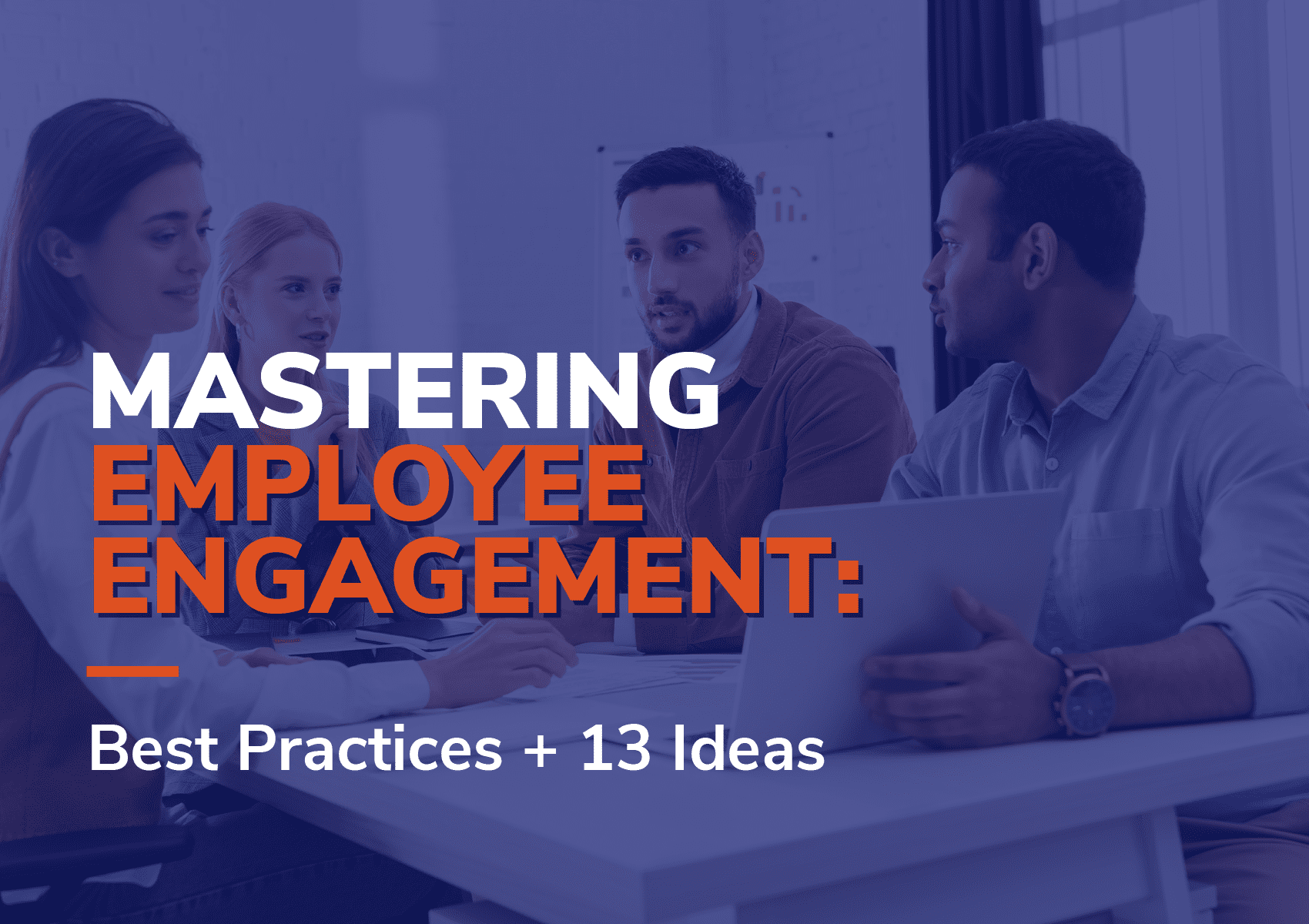
When you hire an employee, you invest in their potential to strengthen your team. So what happens when your investment doesn’t pay off and your organization isn’t as effective as it should be?
If this sounds like your organization, you’re likely struggling with employee engagement. And you’re far from the only one; studies report that 85% of employees are not engaged or actively disengaged at work.
This means more than just losing your employees’ attention at your All Hands meetings. Employee engagement is a major indicator of your organization’s overall health and effectiveness in achieving your goals.
Fortunately, there are many formal and informal changes you can implement into your organization’s structure to keep your employees motivated. In this guide, we’ll cover the following essentials:
- Employee Engagement FAQs
- Employee Engagement Dos and Don’ts
- Employee Engagement Program Ideas
- Employee Engagement Plan Template
Let’s explore why employee engagement is so critical and how you can promote it on an everyday basis.
Employee Engagement FAQs
Whether you’re just now creating your employee engagement strategies or refining your existing approach, you’ll likely want to nail down the basics. Let’s explore some common questions organizational leaders typically have.
What is employee engagement?
eCardWidget’s guide to employee engagement defines this concept as:
The level of commitment and investment employees feel toward their employers, workplaces, and jobs.”
Essentially, employees who are involved in their work and your organization are more engaged than employees who feel indifferent. It’s a measurement of how passionate employees are about their work and how aligned they are with the goals and values of your organization.
Usually, employers measure engagement through employee surveys, one-on-one meetings, exit interviews, and performance metrics. After pinpointing improvement opportunities, organizational leaders attempt to enhance employee engagement through strategies like effective communication, recognition programs, positive work environments, and employee training.
What factors impact employee engagement?
A multitude of factors impact employee engagement, with each one contributing to how connected, motivated, and committed employees feel toward their work and the organization. Factors that typically affect employee engagement include:
- Job role and responsibilities. Employees are more engaged when they find their work meaningful, challenging, and aligned with their skills and interests.
- Leadership style. Do you schedule one-on-one meetings with your direct reports? How about sending informational surveys about how to improve the workplace? Leaders who communicate clearly, show appreciation, and provide guidance usually influence employee engagement positively.
- Organizational culture. This includes everything from a nonprofit’s mission to work-life balance to diversity, equity, and inclusion (DEI) initiatives. A positive, inclusive, and ethical company culture that aligns with employees’ values fosters a sense of belonging and engagement.
- Workplace giving. Employees are prioritizing working for socially responsible organizations more than ever before. If you lead a company, be sure to offer employee giving opportunities, and infuse other CSR practices into your company’s strategies.
- Enrichment and advancement opportunities. Businesses and nonprofits that invest in their employees’ professional development tend to increase their effectiveness and loyalty.
- Remote workplaces. Some organizations struggle more with engaging employees when they’re working from home. However, as we’ll explore later, there are plenty of ways to engage remote employees as well.
- Tech stack. Workplace software that’s meant to improve elements of the work experience can fortify employee engagement.
- Organizational stability. Job security and confidence in the organization’s future can influence engagement. Employees need to feel that their jobs are secure and the company is on a stable and positive trajectory.
- Compensation. Employees need fair compensation and regular raises. Give generous base salaries, and consider other elements of compensation, such as health benefits, retirement plans, paid time off, and other perks.
Understanding and addressing these factors can help organizations enhance employee engagement, leading to better job performance, lower turnover, and overall organizational success. We’ll go over how to evaluate your organization’s strengths and weaknesses when it comes to employee engagement strategies later on.
Why is employee engagement important?
Investing in employee engagement can yield the following benefits for your organization: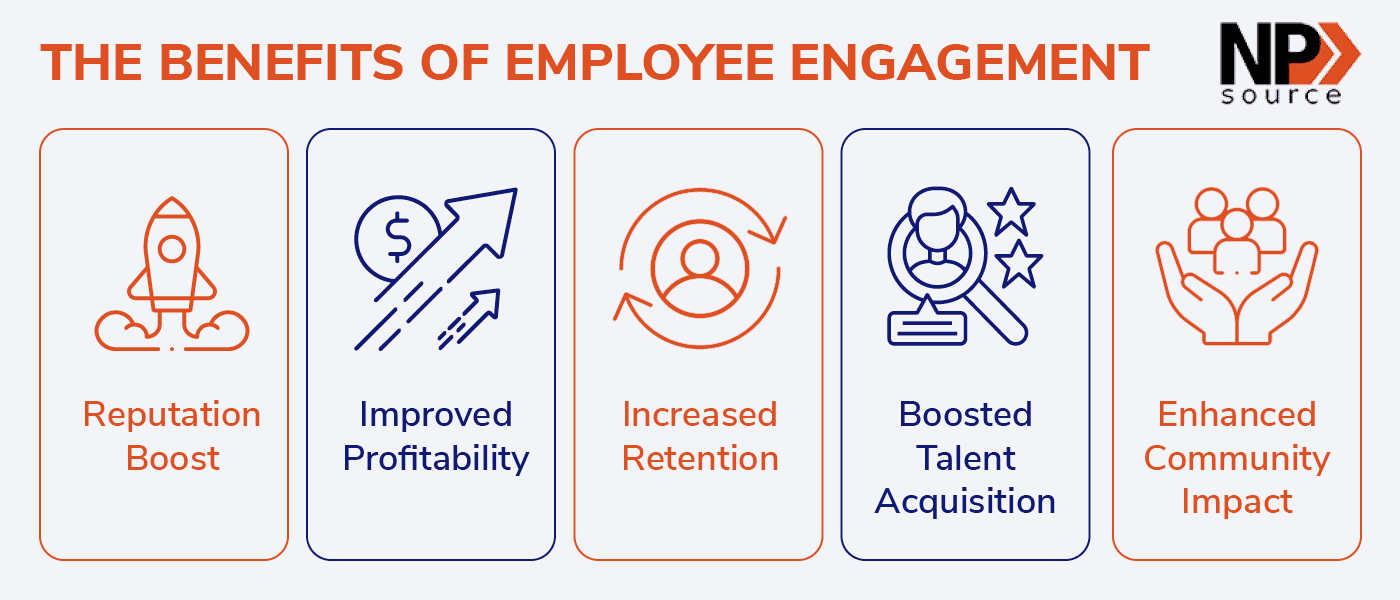
- Public reputation boost. Treating your employees well can translate to positive PR for your organization, which is great for business and hiring.
- Improved profitability. Studies show that high engagement rates can lead to a 23% increase in productivity and quality of work, boosting your revenue.
- Increased retention. Recruiting and onboarding new employees is far more costly than retaining existing trained employees. In fact, Highly engaged business units achieve a 43% difference in turnover.
- Talent attraction. Baking employee engagement into your organization results in better recruitment numbers.
- Enhanced community impact. If your organization takes on corporate philanthropy as an engagement practice, you can change real people’s lives.
What are the barriers to achieving employee engagement?
Before we go over how to implement new strategies to engage employees, let’s discuss the challenges many businesses and nonprofits face when it comes to employee engagement, such as:
- Insufficient training. Each role has specific responsibilities, and training helps set a foundation for each worker’s confidence.
- Lack of leadership support. Leaders are the ones who have the most power to create transformative and valuable programs for their employees, so it can be difficult to create a widespread change without their help.
- Inadequate communication. Even if all levels of the organization are on board with new initiatives, it’s counterproductive when you can’t convey updates to the rest of the team.
- Stress and burnout. When team members have challenges in their personal and professional lives, it can impact how committed they are to their work.
- Unhealthy work-life balance. Similarly, when work bleeds into an employee’s personal life, it can burn them out and decrease efficiency.
- Lack of recognition. Appreciating directs and peers for a job well done is important in boosting morale and confidence across the organization.
- Remote work challenges. The biggest difficulty with remote work is maintaining a human connection with other team members, which is the crux of a strong employee engagement strategy.
- Unclear expectations, performance metrics, and goals. Without an objective in mind or ways to measure progress, employees can feel less driven.
- Lack of inclusivity and openness. Every team member should feel comfortable and valued, so employees might feel less motivated to succeed when those feelings are missing.
- Lack of resources. Not having enough resources to go around makes it more difficult for employees to complete work, leading to burnout.
With these considerations in mind, let’s go over some dos and don’ts when analyzing employee engagement and implementing ideas.
Employee Engagement Dos and Don’ts
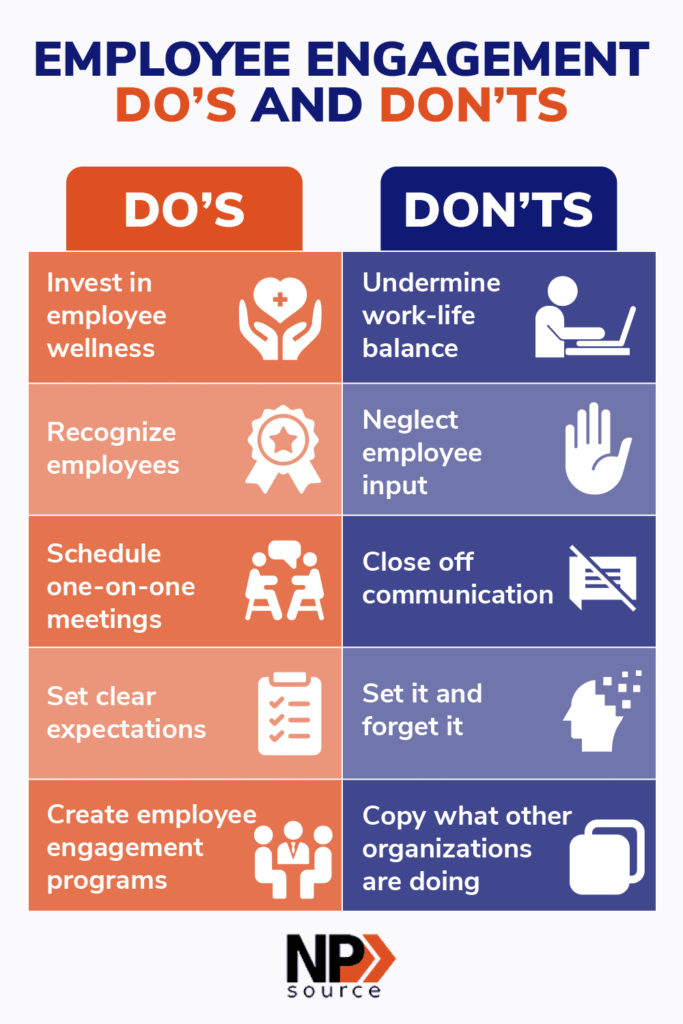
Do:
- Invest in employee wellness. Healthy employees are more likely to be happy and engaged. Add benefits to your employment package such as a gym membership or insurance that covers mental health appointments.
- Recognize and congratulate employees. Your organization can’t succeed without each employee’s efforts, so ensure that you incentivize hard work by recognizing top performers.
- Schedule one-on-one meetings. Depending on your organization’s size, you might not have time to meet with all of your employees one-on-one. Delegate this responsibility to managers so directs have a consistent touchpoint to leadership.
- Set clear expectations. Whether it’s using a task management system or organizing regular pipeline meetings between managers and directs, leadership should always communicate their standards and project updates so employees can structure their workload accordingly.
- Create employee engagement programs. Besides changing your leadership tactics, set resources aside for specific employee engagement programs. We’ll go over some ideas later!
Don’t:
- Undermine work-life balance. Part of prioritizing employee wellness is respecting work-life balance. Set clear standards for when employees are expected to be responsive about work matters, including when they’re taking time off.
- Neglect employee input. Since upper leadership doesn’t spend much time interacting with lower-level employees, it’s important to ask them for their feedback about improving the organization’s culture and work environment.
- Close off communication. Along with leveraging your middle management as conduits between directs and leadership, remember to talk directly to lower-level employees when big updates occur.
- Set it and forget it. Once you implement your organizational changes and new engagement programs, check in regularly and gauge their success.
- Copy what other organizations are doing. It’s great to be inspired by other organizations’ approaches to employee engagement, but remember that you have unique needs and need to adapt your strategies accordingly.
Employee Engagement Program Ideas
The best way to encourage employee engagement is to reserve resources for dedicated programs to boost involvement. Here are some ideas for employee engagement for both businesses and nonprofits:
 General Employee Engagement Ideas
General Employee Engagement Ideas
These involvement initiative ideas are tried and tested in both business and nonprofit settings:
- Professional development opportunities. Whether you’re paying for employees to attend conferences or go back to graduate school in your field, prove that you’re invested in your employees’ long-term growth with professional development opportunities.
- Direct feedback loop between lower-level employees and leadership. Schedule monthly or quarterly skip-level meetings where leaders can talk with directs to keep communication open.
- Mentorship programs. Peer-to-peer mentorship can help new team members acclimate to the organization faster and have a role model in a similar role to them. Leaders can incentivize participation by providing free meals to mentors and mentees.
- Fitness and mindfulness challenges. Healthier employees have more bandwidth to focus on their jobs and complete high-quality work. If you invest in the aforementioned wellness benefits, encourage your employees to leverage them by running fitness- or mindfulness-based challenges. For instance, you could award a prize for the most miles run in a month or reward participation in a daily meditation exercise.
- DEI initiatives. Workers who feel a sense of belonging and connection in their workplace will be more likely to have stronger mental health and perform better. Work with external DEI providers and listen to employee feedback to ensure that everyone, regardless of religion, race, gender, ability, and sexuality, feels valued in your community.
- Advancement opportunities. Promoting from within the organization not only shows that you believe in your employees’ potential but also allows you to promote someone who already knows how your organization works. When hiring for middle- and upper-management roles, consider existing employees first.
- Informal and formal employee recognition programs. Your organization can show your gratitude for your employees’ hard work and contributions in many ways. For instance, you can institute ad hoc, peer-to-peer recognition programs, such as Bravos sent via eCard. Or, you could award an Employee of the Month or hand out awards once a year for high performers.
- Socialization opportunities. The best way for coworkers to build friendly relationships is to get to know each other personally outside of work. Empower them to experience all your community has to offer by providing funds for social outings. For instance, you might allow each employee to plan an event once a quarter with a budget of $35 per person.
Employee Engagement Ideas for Businesses
Consider incorporating the following ideas to reinvigorate your business’ employee engagement.
- Innovation challenges. Highlight an issue in the business that you’d like to fix, such as a lack of sales leads or product issues. Then, open the floor for your creative workers to submit proposals for a great prize, such as extra paid time off or a gift card. This gets employees thinking about your business from new angles, which can deepen their investment in their role.
- Cross-departmental presentations. Building relationships across team boundaries helps strengthen your overall company culture. For instance, you can invite a team member to give a presentation about their team responsibilities in a “Lunch and Learn” format.
- Corporate social responsibility programs. As mentioned earlier, when businesses not only show interest in but actively support their employees’ pursuits, they’re more likely to be loyal to the business and show more interest in their work. Offer corporate giving opportunities, such as matching gifts and volunteer grants, to help your workers make an impact through your business.
Depending on the size of your business, there might be teams that never get to interact with each other. Facilitating these relationships is key to making your business feel more like a community.
Employee Engagement Ideas for Nonprofits
These ideas appeal to nonprofit teams’ unique strengths and community ties:
- Meet and greet with beneficiaries. Your employees work for your nonprofit because they want to be a part of something bigger than themselves. The best way to connect them to your cause is through your beneficiaries. Introduce your beneficiaries to your staff so they can put a face to the campaign they’re promoting and feel more fulfilled in their roles.
- Impact storytelling. On a weekly or monthly basis, get your team together to share a new impact story from a beneficiary perspective. This can not only spark emotional investment from your team members but also transform new marketing and outreach efforts.
When considering how to level up your nonprofit’s employee engagement efforts, remember that you’re already in the business of changing lives. Cultivating connections between your staff and your mission is key to promoting their connection with their daily work.
Employee Engagement Plan Template
In your employee engagement plan, ensure that you include the following information:
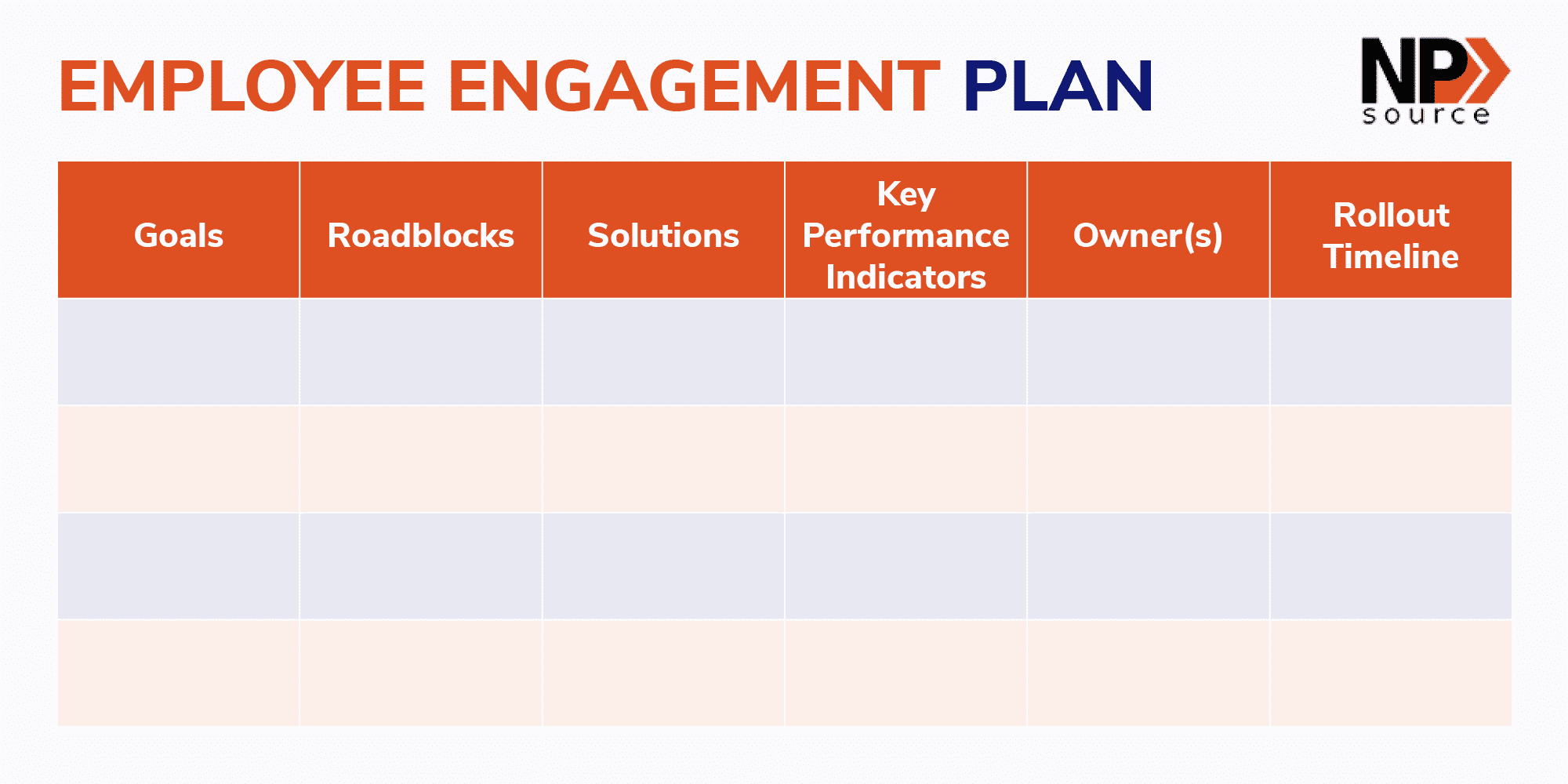
- Goals. The more specific, the better. Follow the SMART format to hone your objectives so you can develop the most relevant plan possible.
- Roadblocks. Similarly, paint a detailed picture of the challenges you’re facing, including qualitative and quantitative metrics from employees.
- Solutions. Come up with actionable solutions that help you tackle roadblocks and achieve long-term growth.
- Key Performance Indicators. Determine which information you’ll collect and how you’ll collect it.
- Owner(s). Ensure everyone involved in the rollout understands their specific role and expectations.
- Rollout Timeline. While your timeline might not be ironed out yet, make your best guesses so you can assess your progress regularly.
Remember to add or delete information as needed to fully customize this template to your organization’s needs.
Final Thoughts About Employee Engagement
No matter if you lead a business or a nonprofit, the crux of employee engagement is ensuring your workers are satisfied and given opportunities to grow personally and professionally. By allowing your employees to lean on and learn from each other, you can transform your workplace into a profitable powerhouse and a community.
Additional Resources
From Cubicle to Community: How to Empower Workplace Giving. Workplace giving is a great way to rally your team around important causes. Learn about infusing your workplace with the giving spirit with this guide.
What is Corporate Giving? The Ultimate Guide to Earning More. There are many facets of corporate giving that nonprofits should be aware of. Get all the information you need here.
Nonprofit Basics: Employee Engagement. One of the biggest challenges of remote work is cultivating a sense of community without face-to-face interaction. Start with these tips to bring your remote employees together.